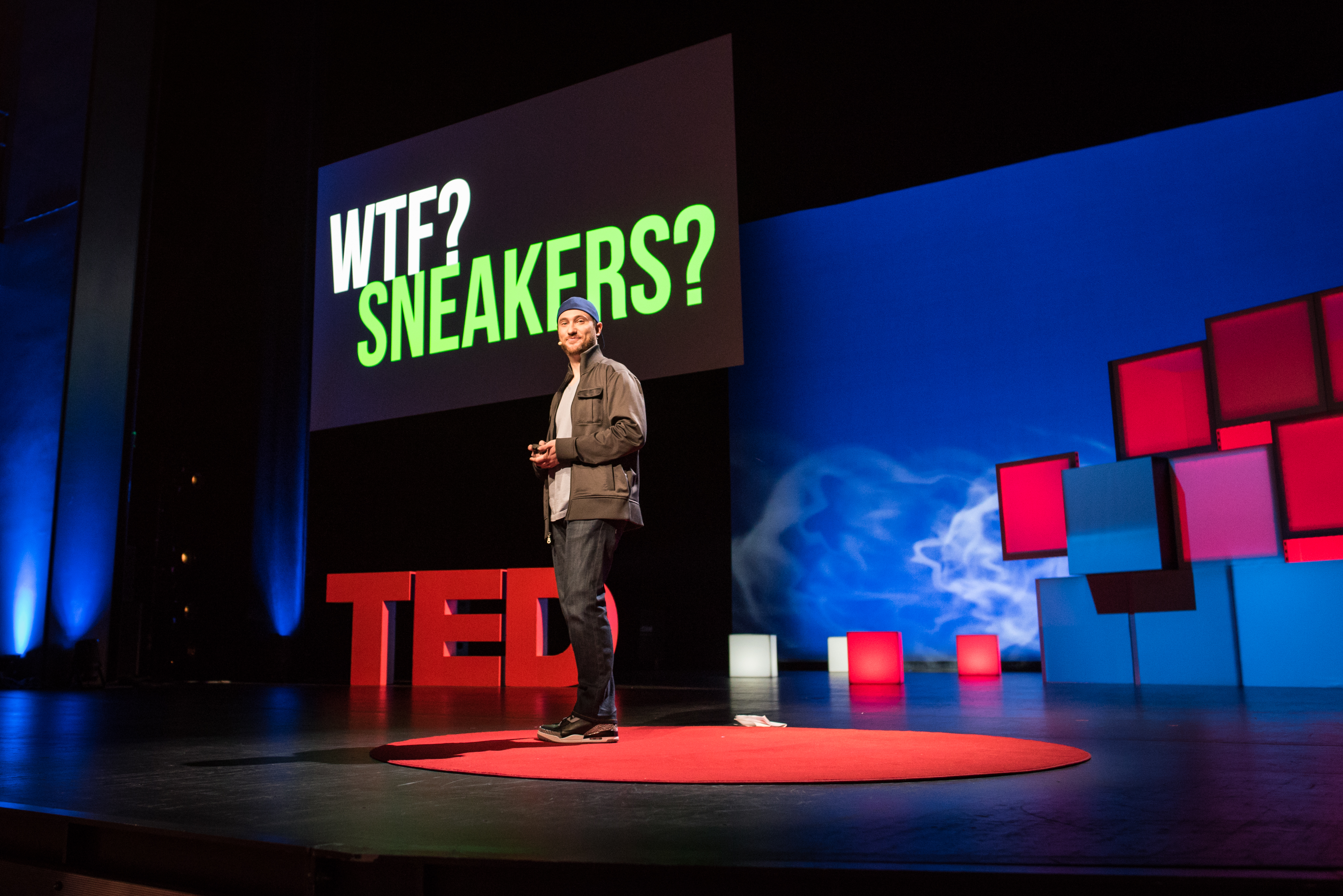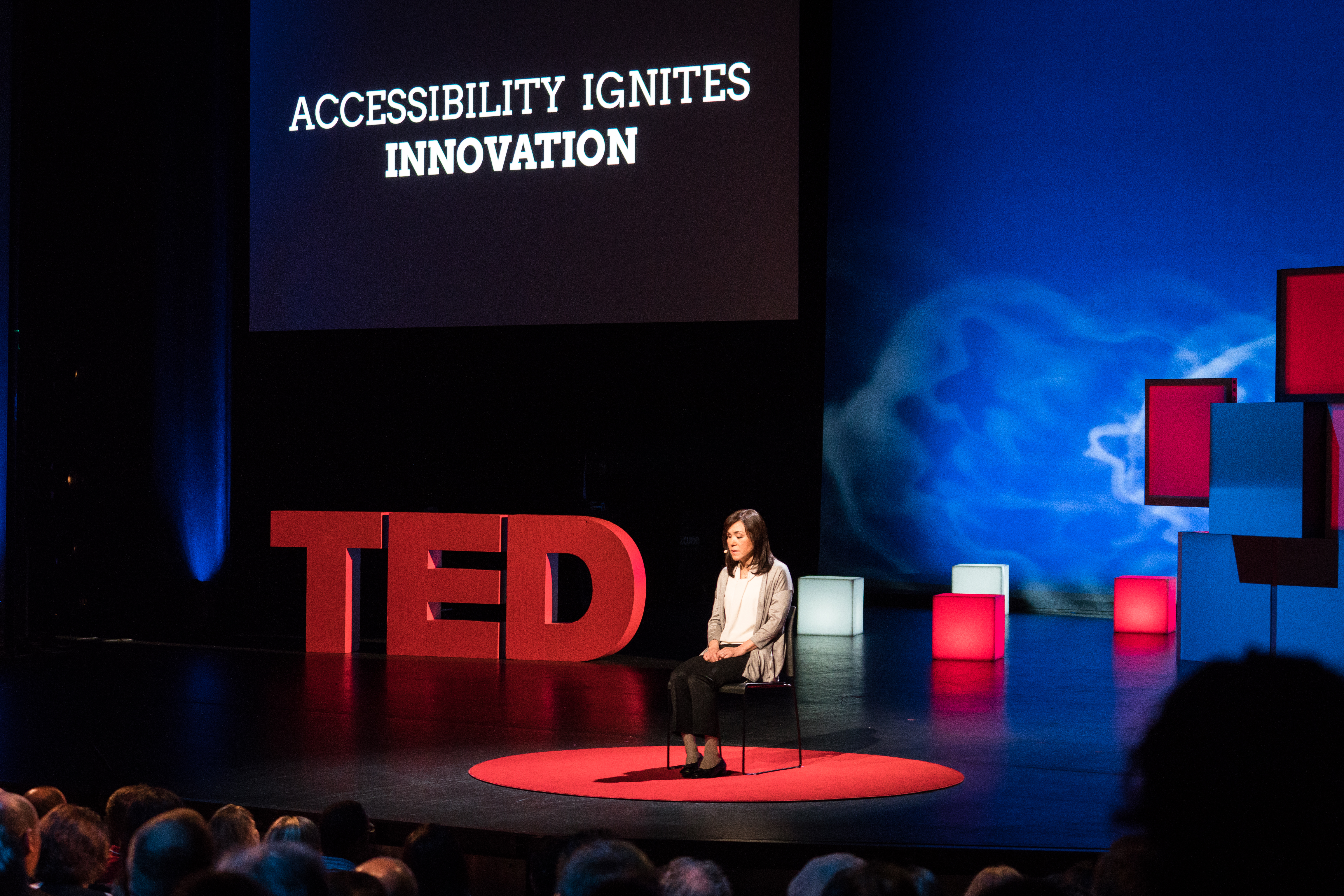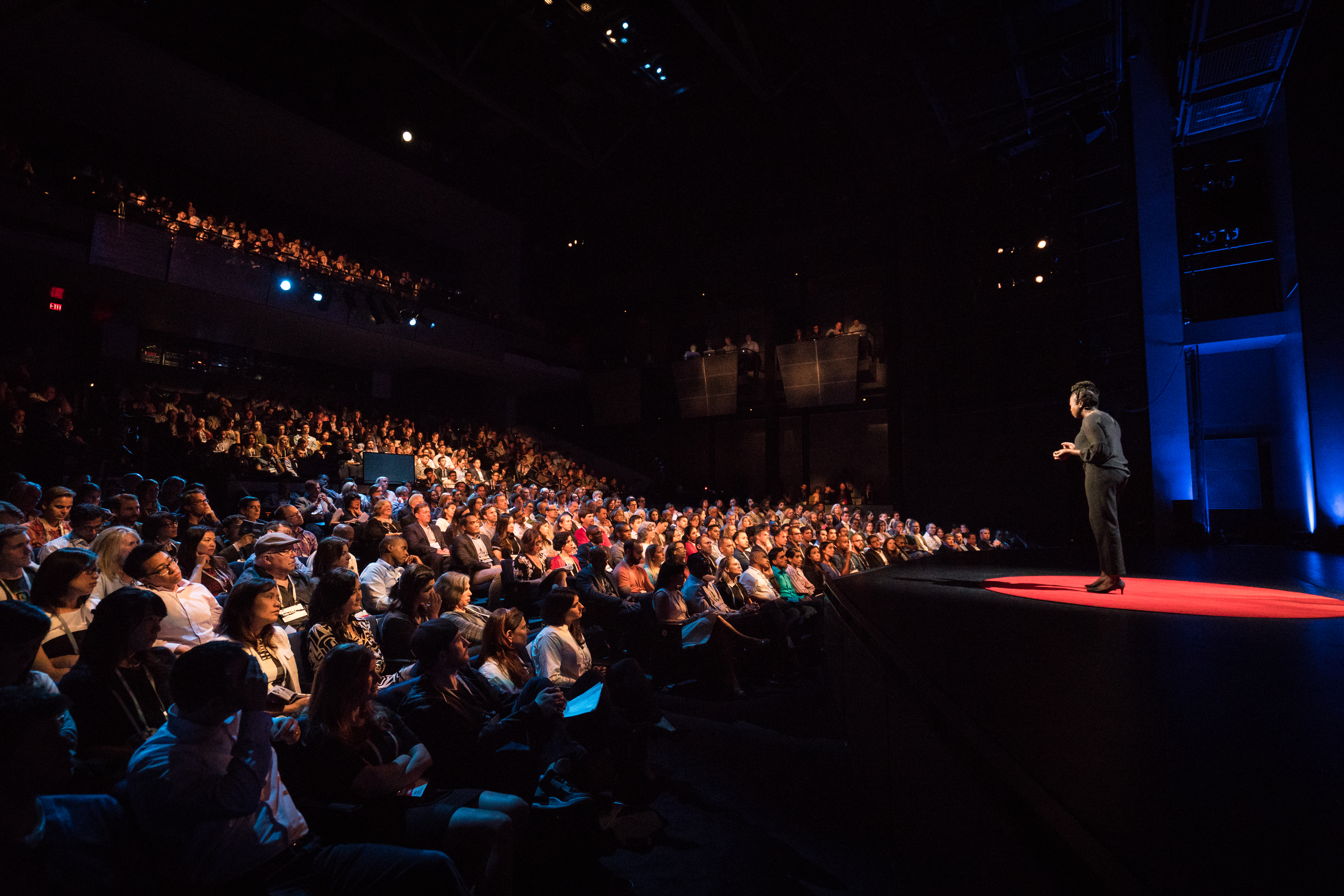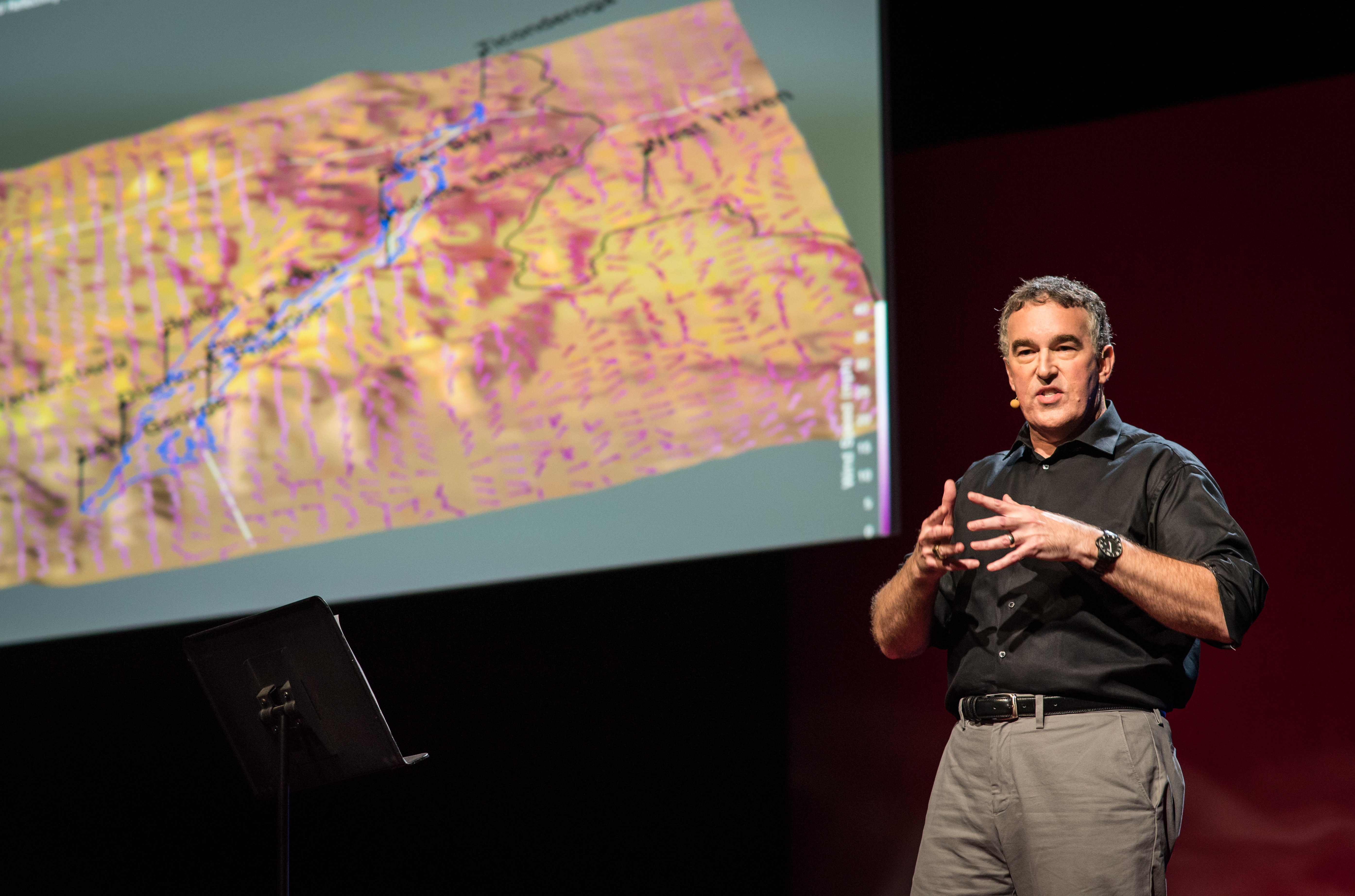
Josh Luber is a “sneakerhead.” In his talk at TED@IBM in San Francisco, he examined the unregulated secondhand sneaker market — a $6 billion a year business. Photo: Russell Edwards/TED
Some inventions are about solving a need. Others are about opening up our understanding of the world. Still others are motivated by a sense of whimsy or adventure. At TED@IBM, 14 speakers shared ideas that fit into all of these categories.
Themed “Necessity & Invention,” the second edition of TED@IBM challenged the often-repeated truism and took a more nuanced look at the human needs to solve problems and create. This TED Institute event took place on October 15, 2015, in San Francisco, and was hosted by TED Fellows Jedidah Isler and Jose Gomez-Marquez. In two sessions of talks, speakers shared innovations as diverse as a new system to distribute water across Africa and a stock market for sneakers. Below, interesting thoughts from each talk.
First, the speakers in Session 1:
“What if we could actually buy sneakers exactly the same way we buy stocks? And what if it wasn’t just sneakers that you could buy this way? What if there was an actual stock market for commerce, a stock market of things?”
—Josh Luber is the founder of Campless, a “sneakerhead data” company which tracks the $6 billion secondary market for sneakers. He takes a look at Nike’s domination of this space and explains how the unregulated sneaker market represents a real investment opportunity.
.
“What you just saw was me recycling a thermoset that is stronger than bone back down to a powder.”
—Chemist Jeannette “Jamie” Garcia focuses on the potentials of plastics at IBM Research. She demos a special polymer that’s unthinkably strong, and yet dissolvable. The implications of this? Recyclable airplanes, dissolvable water bottles and much more.
.
“Financial services do not have to remain a First World privilege. We have the tools and the creativity to give every person the access to credit that they deserve.”
—Eric Mibuari leads IBM’s Financial Services Innovation group in Africa, focusing on the technology at the heart of Africa’s transformation into the “mobile continent.” Working with one of East Africa’s largest commercial banks, he is pioneering a new system which uses mobile and other data sources to create credit-worthiness profiles for informal communities.
.
“As great as our computers are, there is a wall. There is a fundamental limitation of our ability to simulate and understand the detailed structures and interactions of important and crucial biologically relevant molecules and compounds simply because they’re too big. … We need a computing paradigm shift equivalent of taking us from the horse and buggy all the way up to warp drive on the Starship Enterprise.”
—Jerry Chow of IBM’s Watson Research Center creates “qubits,” the building blocks of quantum computing. While regular computers process binary information, for a quantum processor information can be a 0, a 1, both at the same time or anything in between. Qubits are “exquisitely delicate and fragile,” says Chow as he shows us where his team creates them, and chills them to -273 degrees Celsius to maintain their integrity.

Chieko Asakawa lost her sight at age 14. She has spent her career coming up with technology to increase independence for herself and others. She pioneered digital Braille and voice browsers. Photo: Russell Edwards/TED
“Our computers are surrounding us more every day. And the need for them to be more personable and relatable … that’s just going to get stronger. I think computational humor could be the key to making healthy relationships between us and our machines — and also less frustrating lives for us. In the process, it might even connect a few of us.”
—Vinith Misra, an engineer for IBM’s Watson Group, uses computers to generate humor. Taking advantage of the massive amounts of data created each day, he is looking for ways machines can go beyond simple, algorithmic humor and develop personalities that could be described as funny.
.
“Braille went digital many years before digital books existed — in the late 1980s, almost 30 years ago. The strong and specific needs of blind people made the opportunity way back then. This is not the first time this happened. History shows us: accessibility ignites innovation.”
—IBM Fellow Chieko Asakawa invents technology to make the visually impaired more independent, a mission close to her heart as she lost her vision at age 14. She demos her team’s latest project — a system which navigates her through walks, helps her identify objects without touching them and even recognizes people, and their expressions, before they speak.
.
“Never before have young people had this much power, positioning and potential to change the world. … Millennials harness the power of our fully connected world, embrace an entrepreneurial mindset and collaborate at mass scale.”
—Jared Kleinert founded a marketing consulting firm helping leaders and companies recruit and retain millennials. He’s studying how this next generation of innovators and entrepreneurs is thinking about change.
.
And the speakers in Session 2:
“Personal technologies like our iPhones, email, Twitter, Snapchat and WhatsApp change our daily behavior. They keep us checking again and again. These products are masters of habit.”
—Nir Eyal studies “habit-forming” technology design, thinking about the intersection of tech, psychology and business. He gives a peek into how companies hook into our negative emotions like loneliness and boredom and make their products the solution. This isn’t all manipulation, he says, but can be used for good.
.
“It’s not that new ideas don’t exist within big companies — there are often rebels within these companies who have ideas that go against the momentum. … It’s precisely these rebels that big companies need to reinvent themselves from the inside.”
—Shoel Perelman, a VP at IBM, shares a wacky idea: an “online dating” system to match up big companies and rebel thinkers, so that they can team up to innovate.

Kala Fleming thinks there’s a better approach to improving access to clean water in Africa than digging wells. She wants to look at the system as a whole — an approach that would help California, too, she says. Photo: Russell Edwards/TED
“What if food could talk? What if food is talking right now, and we just need to learn how to listen?”
—Computational biologist Robert Prill looks at how the harmless microbes that live on food could tell us a lot about its quality and safety. He shares the story of how thousands of babies in China got kidney stones when a company watered down formula and added a chemical to cheat quality tests. He then walks us through how microbes could alert us to tampering, or to the presence of high levels of mercury or lead.
.
“What does this mean for the future? Data leaks, hacks and identity theft that we read about regularly will no longer be headline news. With privacy preserving technology, we can get back the control and value our personal data properly.”
—Maria Dubovitskaya, a cyber security researcher at IBM Research Zurich, designs cryptographic protocols for privacy protection. Her latest project: the zero-knowledge proof, which offers users a way to verify their identities online while withholding sensitive personal information.
.
“What people always seem to get wrong is that there is not a lack of water in Africa. In fact, the supplies are plenty. … Africa has more than a trillion cubic meters of underground water.”
—Kala Fleming thinks about water management at IBM Research Africa. She points out that drilling one well isn’t working. Her team is creating a system-level solution, “digital aquifers.” They’re putting sensors in wells, monitoring the data from the cloud and opening up business opportunity around it. To great applause, she points out that California could benefit from this approach, too.
.
“We have to be able to predict the impact of weather. By predicting the impact, that means that we can move from merely a weather forecast to a weather forecast that’s actionable. … As one of my former bosses once said, ‘You don’t get points for predicting rain. You get points for building arks.’”
—Lloyd Treinish is helping us reevaluate our relationship with the weather. As the leader of the global environmental science team at IBM Research, he’s working on tools to improve weather forecasting, to get rid of the common skepticism that forecasts are always wrong. This can save money — and lives, he says.
.
“We need to look towards our kids and do everything in our power to set them up for happy and healthy lives. And I think that the solution is play. It’s creating fun ways for children to engage with, understand and communicate their health. While it might not be a silver bullet, play is an untapped resource for our healthcare system.”
—Aaron Horowitz is the co-founder of Sproutel, creator of Jerry the Bear — a smart toy for wellness education that is changing the way children with type 1 diabetes think about their disease.

Lloyd Treinish is as sick of inaccurate weather reports as you are. He’s working on tech to improve our relationship to the weather. Photo: Russell Edwards/TED
Comments (3)